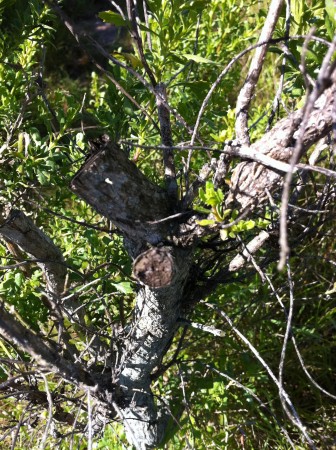Yesterday Linda and I took a brief hike on the Jesusita Trail in Santa Barbara. The area we were walking through was burned in a 2009 wildfire, but it has mostly recovered now. Still, there are signs of the fire — blackened stumps and twigs — if you look for them. There is also a fair amount of coyote brush (Baccharis pilularis), so naturally that ended up being the focus of my attention.
I was surprised to see that there were no Rhopalomyia californica bud galls on any of the plants. I’m not sure why that is. Maybe it’s a legacy of the fire, with the gall midges taking a while to reestablish themselves. Or maybe this is typical of coyote brush stands higher up in the foothills. The Jesusita trailhead is more than three miles inland, while most of my experience with coyote brush has been at the salt marsh and the Carpinteria bluffs, right next to the ocean. Maybe R. californica is more of a coastal species?
At one point I was looking at a spindly clump of burned stems emerging from the center of an otherwise-green coyote brush, when I realized that the exposed stems had the characteristic thickening of the twisted stem gall midge, Rhopalomyia baccharis. I broke off a few of the galls and brought them home for closer examination. Here they are in my hand, to give you a sense of scale:
If you look closely at this shot, you can see the elliptical openings through which the adult midges emerge:
I think these twisted stem galls are fascinating, and I’m always looking for them, but whether it’s that they’re actually rarer, or just that they’re harder to spot in the foliage, I almost never find them. I come across dozens of terminal bud galls for every twisted stem gall I find.
Back in February I found a coyote brush at the Carpinteria salt marsh that had a lot of twisted stem galls; eight or nine at least. I was excited by the find, but I was also in something of a hurry, so I just snapped a few quick photos, intending to come back later and investigate in more detail. Here are some of the shots I got:
The next chance I had to visit the marsh was a few weeks later. I assumed I’d be able to find the plant quickly (the galls gave it a distinctive, gnarled appearance), but I ran out of time without finding it. By the time I could get back to the marsh for a more thorough search it was early April. Even looking more carefully, though, I couldn’t locate the plant. One was in the right spot, but it was much smaller than the plant I remembered, and had no visible galls, so I dismissed it quickly.
Where were the stem galls? I really had seen them; I had photos to prove it. But now they just weren’t there. I wandered back to the center of my search pattern, next to the small coyote brush, and stood there scowling.
And happened to take a closer look at the plant:
Oh.
I suddenly remembered a conversation I’d had recently with Andrea, the head of the docent program, about some new workers hired by the city, with whom she’d had words about their over-zealous pruning of the native plants. The workers had seen the coyote brush with its noticeably gnarled stems, and had done what any self-respecting gardener would do: They’d pruned away the damaged branches.
Sigh. My quest for twisted stem galls continues.

















